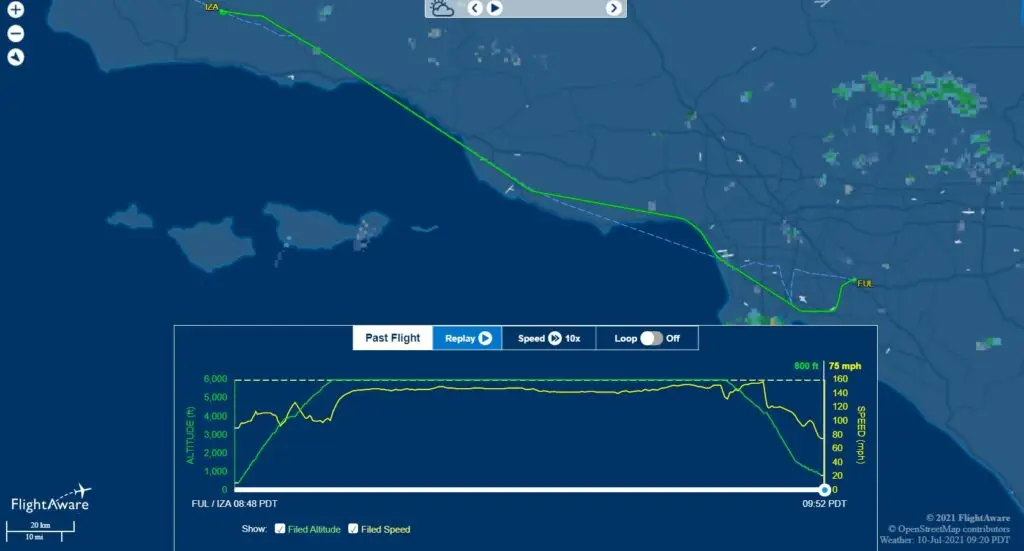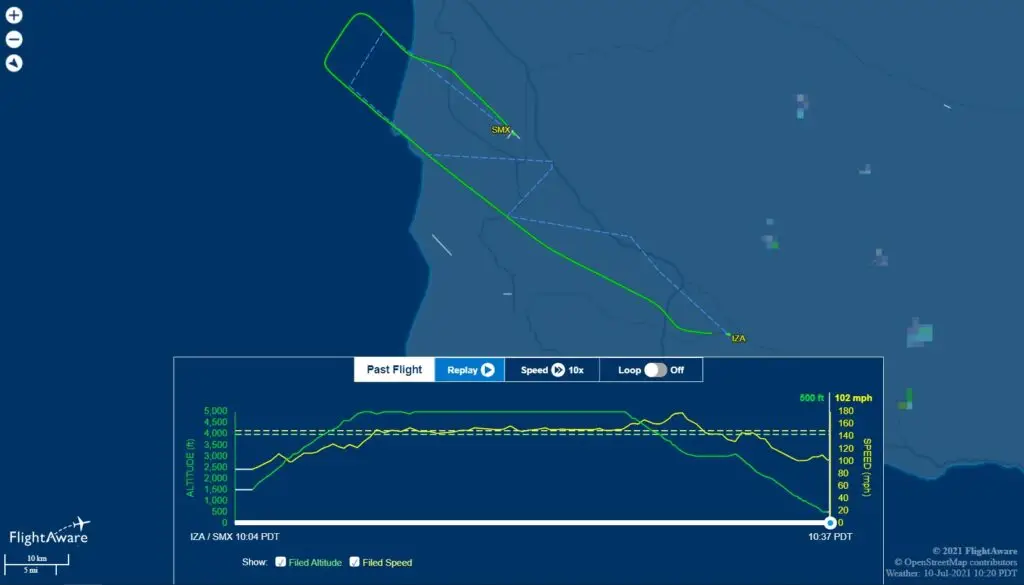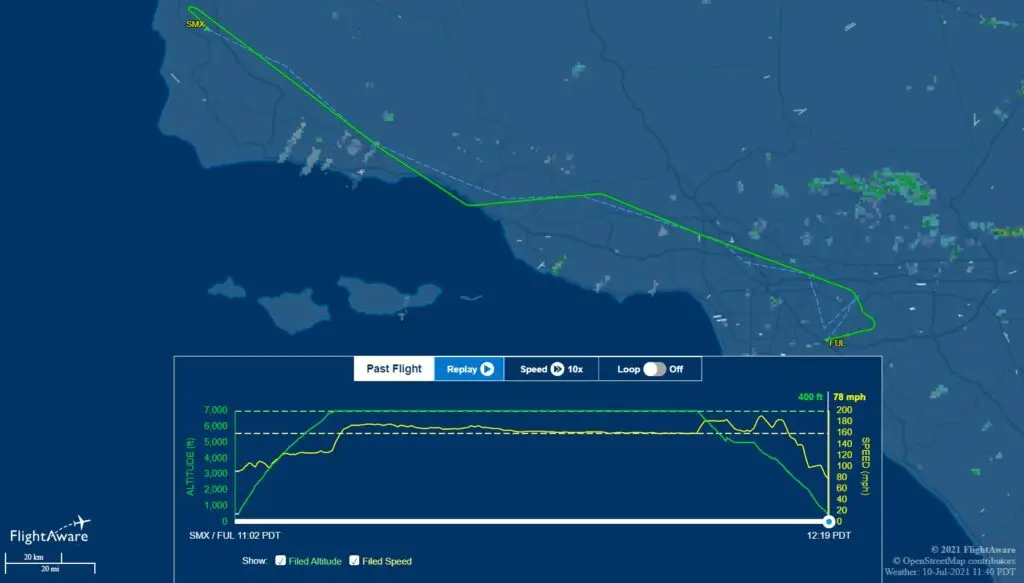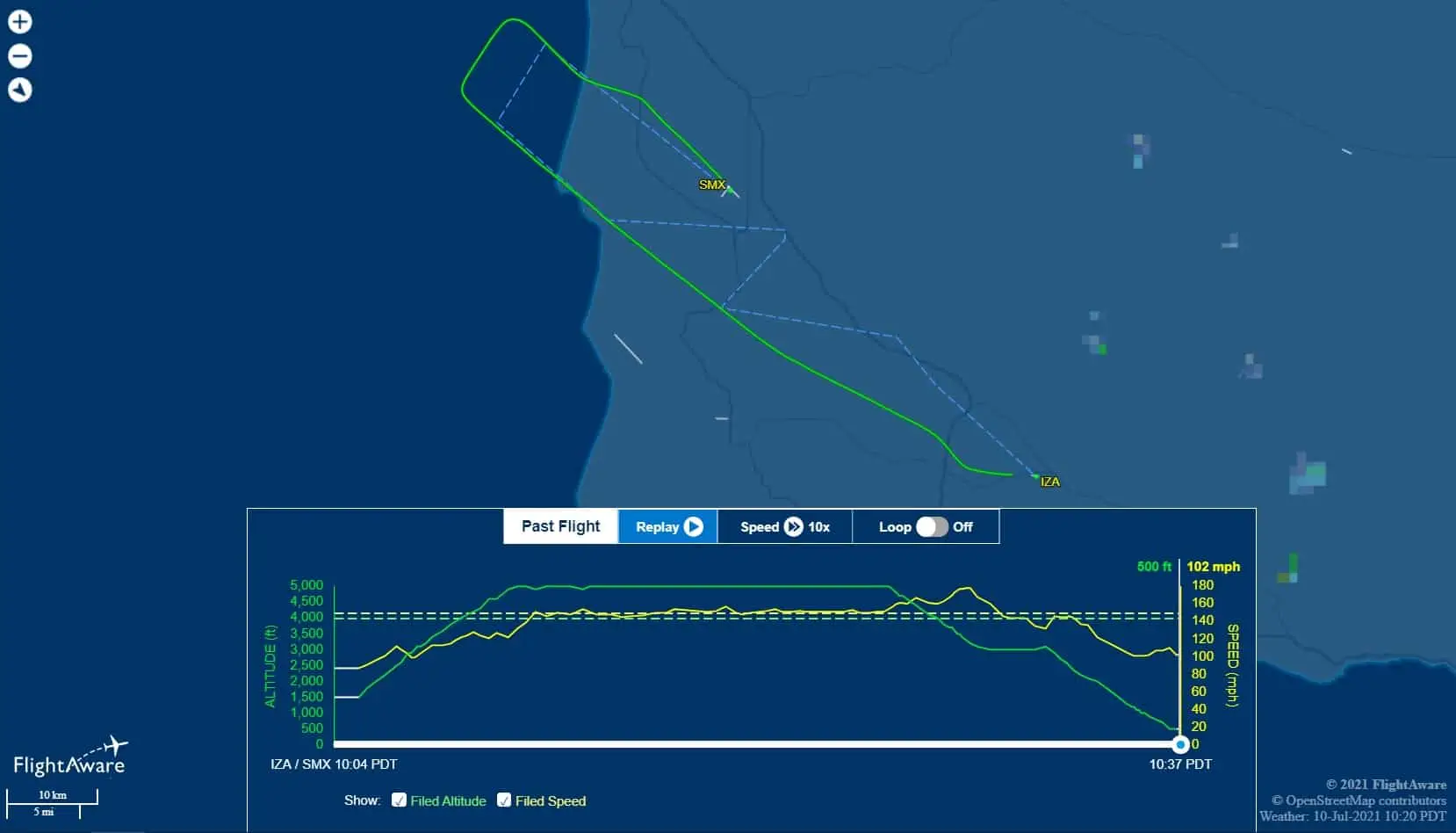Among the requirements for the IFR rating is the IFR Cross Country flight. It must me a flight of 250 nautical miles along airways or by directed routing from an air traffic control facility, an instrument approach at each airport, and three different kinds of approaches with the use of navigation systems. I reviewed distances to airports and the approaches that are available and decided to fly from Fullerton (KFUL) to Santa Ynez (KIZA), then Santa Maria (KSMX), and back to Fullerton.
The straight line distance of the flight is 276 nautical miles. We would fly the GPS-A approach at KIZA, the RNAV RWY 12 approach at KSMX which is an LPV approach, and the RNAV RWY 24 at KFUL which is an LNAV approach. Minimums for the RNAV RWY 12 approach at KSMX are 430′ MSL which is 200′ AGL and would qualify as a precision approach.
Flight 20 – July 10th
The day before I looked up the preferred routing and filed IFR flight plans. I made notes with the filed route, estimated times en route, and estimated fuel burns. I had a different sheet for each leg of the flight so that I had plenty of room for notes from ATC.
I woke up and after eating breakfast pulled out my laptop to get weather briefings for the flights and then headed down to the airport early to pre-flight the plane and fuel it up. When my CFII arrived we went over the flight plans and then I pulled the plane out of the hangar, we climbed in, and I started it up.
My plan was to use the autopilot for the en route sections from KFUL to KIZA, hand fly the leg from KIZA to KSMX, and then use the autopilot again from KSMX back to KFUL. I would turn off the autopilot and hand fly all the approaches. After the engine run-up and configuring everything for takeoff I called up ground to pick up our IFR clearance.
Me: “Fullerton Ground, Mooney 78878 in the south east runup with Lima, ready to copy IFR.”
Ground: “Mooney 78878, Fullerton Ground. Cleared Santa Ynez, on departure left turn heading 230, radar vectors Los Angeles, Ventrua, San Marcos, San Marcos radial 277 CALLI, Direct. Climb maintain 2,000 expect 6,000 one zero minutes after departure, departure frequency 125.35, squawk 4631.
Me: “Cleared Santa Ynez, on departure left turn heading 230, radar vectors Los Angeles, Ventura, San Marcos, San Marcos radial 277, CALLI, Direct. Climb maintain 2,000, expect 6,000 one zero minutes after departure, frequency 125.35, squawk 4631, 878.
Ground: “Mooney 878, readback correct, advise when ready to continue.”
Me: “We are ready.”
Ground: “Mooney 78878, taxi Runway 24 via Alpha.”
Me: “24 via Alpha, 878.”
On my note pad I had written:
C – IZA
R – L230 vLAX VTU RZS RZS 277 CALLI D (for direct it is a capital D with an arrow pointing through it to the right)
A – 020 ex 060 10 min
F – 125.35
T – 4631
We got to the end of the taxi way, I called up the tower, and we were given clearance to take off. As we lifted off and began the climb out I pulled up the gear, retracted the flaps, and gave my CFII the controls so I cold put on the foggles. Once established and trimmed out in the climb I activated the autopilot.
The reduction in workload when the autopilot is flying the plane is palpable. I basically assume the roles of flight engineer, navigator, and radio operator while the autopilot was the pilot. For a little under the next hour I was watching the engine monitor for the engine health, the attitude indicator, directional gyro, and altimeter to make sure the autopilot was doing what it was supposed to, and listening and talking on the radios while dialing in assigned headings from Air Traffic Control.
We were cleared for the approach into Santa Ynez so I clicked the red button on the yoke to disconnect the autopilot and hand flew the approach. The approach starts at 6,000′ over the San Marcos VOR which is about 19 miles southeast of the airport. It flies a heading of 287 degrees for 9.3 miles descending down to 3,900′ at a fix called NOXOQ which is right over Lake Cachuma. At NOXOQ you make a left turn to a heading of 264 degrees and continue the descent to the airport. Straight in approaches are discouraged at KIZA so although the final approach heading is 264 for runway 26 I flew an upwind leg and crossed over the airport to enter a left downwind for runway 26.
Santa Ynez is not a towered airport so once on the ground I called up Santa Barbara Departure on the radio to cancel our IFR and we taxied back to the departure end of runway 26 and I reconfigured for departure. Once through the checklist I swapped out the sheet on my kneeboard for the next leg and called up departure for our IFR clearance.

The clearance to Santa Maria was much shorter. “Mooney 78878, Cleared Santa Maria via Santa Ynez Obstacle Departure Procedure, ORCUT, Direct, climb maintain 6,000, frequency 124.15, squawk 4774. Clearance VOID if not off by 1707 Zulu.”
Because KIZA is non-towered ATC gives you a clearance VOID time. If you are not off the ground by that time you have to obtain a new clearance or cancel the IFR plan.
I had already written down what was filed on my kneeboard to cut down on the writing before calling up Departure, leaving enough room to make changes. On my kneeboard I had written:
C – SMX
R – ODP ORCUT D
A – 060 (I initially had 040 written down as I had filed for 4,000′ but crossed that out)
F – 124.15
T – 4774
I had chosen this leg to hand fly because it should have only been about 15-20 minutes. Once I had our clearance I switched back to the CTAF (Common Traffic Advisor Frequency). I listened to make sure the pattern was clear, announced our departure, took runway 26, and we began a climb out. I briefly gave the controls to my CFII so I could put the foggles on and then took back control of the plane and called up Departure.
The winds at Santa Maria were variable at 4 knots and runway 30 was in use. However, the RNAV RWY 30 approach is an LNAV with an MDA (Minimum Descent Altitude) 1,600′ MSL which is 1,339′ AGL and would not qualify as a precision approach. For purposes of the IFR Cross Country requirement I needed to fly a precision approach.
I requested the RNAV RWY 12 approach and was advised that there would be a delay for sequencing and if I still wanted that approach. I confirmed that I did and was told “fly heading 300.” We continued on that heading for the next 14 minutes and 30 miles. As we passed into one of the restricted areas at Vandenberg AFB I mentioned to my CFII, “The Restricted area must not be hot right now, he has us flying right through it.”
Finally we were vectored onto final approach. As the altimeter approached 430′ I pulled off the foggles and there was the beautiful 8,000′ long, 150′ wide runway right in front of us. What I thought was going to be a short 15 minute flight turned into 33 minutes but it was good to hand fly the whole thing. We made a pit stop at the FBO for a restroom break, then climbed back in, started up, and received our IFR clearance for the final leg of the trip.

For the flight back to KFUL I engaged the autopilot once established in the climb out and resumed the roles of flight engineer, navigator, and radio operator. I should note that I always have those roles when flying, but normally have pilot stacked on top of them. The flight back to KFUL was my favorite type of flight, uneventful. As we approached the ADAMM intersection I was given vectors and told to intercept airway Victor 394. Knowing that would work us around to the VOR approach to KFUL, I requested the RNAV RWY 24 approach. He was happy to give us new vectors as that keeps us out of the busy airspace to the south of KFUL.
One back at the hangar I pushed the plane in and my CFII filled out my logbook with the entry. It was great to get the Cross Country requirement completed, the only thing I have left now is finishing up another 17.6 hours of actual or simulated instrument time before I can take my check ride.



